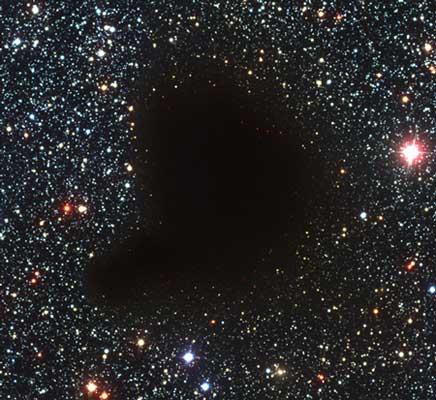
An optical photograph of the starless core, Barnard 68. Astronomers have combined chemical analyses with observations at submillimeter wavelengths to determine that this dark cloud is pulsing.
One of the goals of modern astronomy is to better understand how stars form -- knowledge that will help us model how own sun behaves and will evolve, and how the earth formed as well. All stars are thought to begin in roughly the same way. Gravitational forces coalesce the gas and dust in an interstellar cloud until the material forms clumps dense enough to become stars. How this happens, however, is very uncertain. Sometimes the collapse may be triggered by incident shocks, for example; alternatively, the process may be much more gradual, constrained by internal magnetic fields.
Starless cores are clouds of gas and dust that show no evidence of having any stars. They are usually small and cool, and make valuable examples in part because they could represent the earliest stages of star formation. The starless core Barnard 68 is located about 300 light-years away from earth in the direction of the constellation Sagittarius. It is only a thousand or so astronomical units in size (one "astronomical unit" is the average distance of the Earth from the Sun) and contains only about one and one-half solar masses of material. Nevertheless the molecules it does contain, including carbon monoxide (CO) and others, show evidence for global, organized motions. Several years ago, SAO astronomer Charlie Lada and his colleagues argued that the motions were consistent with material moving both in and out radially, rather like the pulsing of a heart.
In a new paper published last month, Lada and two colleagues invoked the principles of chemistry to clarify the astrophysics of six of the molecular species seen in Barnard 68. Their chemical analysis shows that the abundances of these different species vary throughout the cloud in systematic ways unique to each molecule. The motions of this gas, therefore, as revealed by the submillimeter observations of the molecules, can be associated with specific radial distances from the core center. Their results confirm and supplement the original hypothesis about oscillating gas. Knowing that these motions are organized, not random, the astronomers calculate that the core is relatively old, a few million years, and therefore considerably older than a shock-induced scenario would predict. The result not only helps to clarify how stars form, it emphasizes how multidisciplinary thinking can make key contributions.